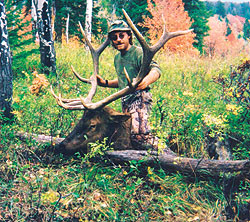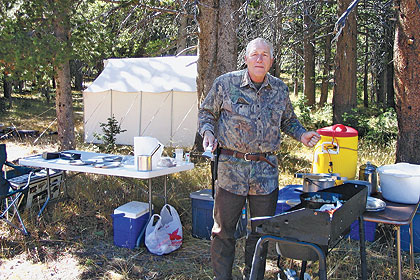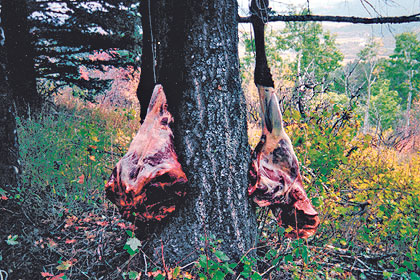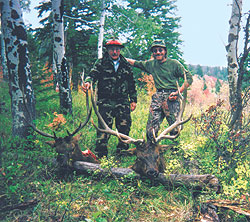October 28, 2010
By Ron Mueller
Know where elk are going — and get there first!
By Ron Mueller
 Tom Mueller poses with his 6x6 trophy bull elk, which went less than 100 yards after the shot. This bull was taken by climbing higher than the herd before dawn and intercepting the bull as he headed toward a bedding area. |
Have you ever been into a herd of elk where the bull would answer your call, but every time you got close, he would move the herd away? When you bugled, he bugled? And then, when he bugled again, he was further away? If so, you were playing catch-up, which is fun, but the bull usually wins. It happens all the time. If you get aggressive, he won't close. If you try to act like a lonely cow, he won't leave the cows he already has.
One solution to this dilemma is to figure out where the herd is headed. Then, with a little luck, get out in front and cut them off at the pass. Sometimes this isn't possible, but other times it works.
Advertisement
Early-Morning Opportunity
It was early in the morning as we drove up the logging road in John's '88 Chevy, a slightly rusted but reliable 4x4 pickup, to go elk hunting in the Salt River Mountains of western Wyoming. Along with this 70-year-old, seasoned hunter were my son, Tom, and my friend, John Potee. We were winding up the hill when John spotted elk in the headlights crossing the big clearing a couple hundred yards ahead.
Sure enough, there was a herd of elk coming out of a meadow, the ghostly figures moving quickly and heading south through the sagebrush and over the ridge toward deep timber. We drove past where the elk had crossed and continued driving up the hill for half a mile, where the logging road ended. It was still too dark to hunt, so we poured some hot coffee from our Thermos and waited.
Advertisement
From observing these elk in previous years, I knew their normal pattern was to feed in the pre-dawn hours on the lower hillsides and meadows, then meander up one of the finger ridges to the top of the main ridge and then down into the dark timber to bed. Our plan was to work above the elk, locate them, and cut them off if they started up one of the finger ridges.
 Part of elk hunting is enjoying a good camp. John Potee cooks a lunch of bacon, eggs, and fried potatoes after a morning hunt. Good food and a comfortable wall tent with wood-burning stove are hard to beat after hours of hiking up and down ridges. |
Emptying our coffee cups and readying our gear, we were ready to saddle up with our backpacks and head out. The stars were shining brightly, and cold air sent a chill through us, but we knew we would soon be warm from the exertion of a steep, uphill climb.
Still in the dark, we used our small flashlights to work our way up through the brush and timber to the top of the first finger ridge. By the time we got to the top of the ridge, there still wasn't enough shooting light. The sky was starting to turn bluish, with Venus, the morning star, visible with a few puffy pink clouds and the sun outlining the mountains on the horizon to the east.
Our first bugle was answered by a couple bulls over and down the next ridge. We checked the wind with our butane lighters; a slight breeze was moving uphill away from the elk toward us, which was good. We found a game trail and crossed a ravine over to the next finger ridge, above where we had heard the bugles.
John bugled again, and Tom made a couple soft cow calls. For cow-like sounds, Tom uses a Primos diaphragm call, and for bugles, grunts and squeals, he uses his voice with a grunt tube for resonance. They sound very much like an elk. Elk answered from three different places; there were at least three bulls, and there was some competition. So far, our plan was working. We were above and out in front the elk, and they were vocal.
Under these conditions, we might have a chance at the herd bull. The date was Sept. 22, the cows were in estrus, and the bulls were hot to trot.
 After a bull elk is on the ground, the real work begins. Here, two freshly processed elk quarters hang in the shade of a Douglas fir tree. |
When A Plan Comes Together
We checked the wind again to make sure it was still OK, then set up to see if any of the bulls would close and come check us out. Tom was slightly down the ridge, John was above, and I dropped back off the ridge slightly to be the out-of-sight caller. John motioned and signaled to me that there was an elk above us. Sure enough, a little spike slowly worked his way in our direction. He came in to about 40 yards for a look-see; John worked his way up to him but couldn't get a shot in the thick timber.
Then, a bull roared from below. Tom gave a couple cow chirps, and in he came. I couldn't see him, but I could hear him squeal and give some chucks as he approached.
When he was close to Tom, I bugled, hoping he would look up where I was and not at Tom.
Tom shot, and the bull charged off, tearing up chunks of frosted mud and grass as he retreated into the aspens and red maples from whence he came. I bugled, and Tom cow called, trying to slow him down or stop him. Then there was deathly silence, and only the squawk of some high-flying sandhill cranes could be heard. Tom came back to me and said the bull was a big 6x6, and the 30-yard shot hit a little higher than he wanted.
We marked the spot where Tom had shot with a little toilet paper and settled in for a 30-minute wait before we started tracking. We took off our packs, had some water, and I marked the location on my GPS unit.
Another bigger spike showed up, circling around trying to see what was going on. John bugled at him and tried to move into position for a shot, but the spike didn't stick around.
Suddenly, another bull bugled from just below us. He was coming up the hill from the same place as the first bull! I moved down toward him, got into position on my knees and readied for a possible shot. Tom cow chirped, and I could see the tips of his antlers moving ever closer through the brush. When you see those antlers slowly coming through the aspens, your heart rate tends to pick up a few beats. Fifty yards, 40 yards, he slowly plodded closer and closer.
Tom would give an occasional, enticing chirp, and the bull was being drawn to the magnetic cow call. Just seeing the top of his antlers, he looked like a rag-horn 3x3. Where I anticipated he would come through for a possible shot, there were downed logs and brush in the way. I would have to stand to shoot. At 30 yards, he moved between two aspens, and I let the arrow fly.
The bull whirled and ran down the ridge through the aspens, and in a blink of an eye, he was gone. Again, we bugled to slow his retreat. It was a good, clean shot, and the arrow went completely through, disappearing in the grass on the other side.
I never did see the cows. I'm going to guess the herd bull was busy chasing satellite bulls away and was temporarily separated from them. But nonetheless, we were successful in getting in front of the herd and shooting our elk. It was one of those rare times when a plan comes together and everybody does the right thing.
 Author Ron Mueller (left) and his son Tom Mueller pose with the bull elk they took within minutes of one another during a successful Wyoming hunt. Ron Mueller's bull was a 5x5, while Tom Mueller's was a Pope and Young caliber 6x6. |
Trackin' And Packin'
After what seemed like a long 30 minutes, we started our tracking. When tracking an elk that has been mortally wounded, we move quietly, marking any blood sign with a small piece of toilet paper on a tree or bush. One hunter scouts out front looking for fresh sign, and the other hunter stays back looking near the last sign of blood. If some fresh blood is found, the point man gives a soft, bird-like whistle. Then, we leapfrog, changing places.
If we lose the trail, we can always go back to the last piece of toilet paper.
The tracking job was short. We had just started when Tom gave a little whistle and pointed downhill to where his bull was laying. He had huge antlers and was a beautiful animal. Tom moved in slowly with a nocked arrow, just in case there was any life left in the bull. I found my bull a few minutes later. This had been one of the easiest tracking jobs we ever had; both bulls were stone dead 100 yards from where they were shot.
Tom's bull was a large 6x6, most likely the herd bull, which green scored over 300 inches. Mine was a small but nice 5x5. Both Tom and I had made double-lung shots, which really do the job with amazing speed and efficiency.Tom's arrow broke a rib going in and lodged in the hide on the opposite side. Mine went cleanly between the ribs going in and coming out. I jokingly suggested that next time, he should aim between the third and fourth ribs for improved penetration. "Oh yeah. Sure," he groaned, and rolled his eyes.
This was incredible! Never had we shot two bulls (never mind one of Pope and Young caliber) at the same time, and they were laying dead less than 40 yards apart.
That would have been a good time to take some pictures of the elk, but none of us had a camera. Bummer! When you get your elk down, it's so important to get some photos right away. Next time I go hunting, you can bet your best broadhead a camera will be in my pack. John said he had one of those disposable cameras down in the pickup. So, away went John, carrying our bows to save a trip, to fetch the camera.
It was mid-afternoon before we had both elk quartered, skinned, in game bags and hanging in the shade of the nearby Douglas firs. The meat would be nice and cool by the time we returned the following morning with our pack frames. We sawed the antlers off, pried out the ivory teeth, loaded the heart and liver and headed back to the pickup.
Spotting elk, knowing their patterns and then getting out in front of them does work. Make the most of this coming elk season and don't get left behind!
Ron's Rancho Safari Pack
I use a Rancho Safari Catquiver IV backpack/quiver combination, which I always keep stocked with, among other things: a hunting knife and sharpening stone; bone saw; four, 15-foot sections of nylon rope; four cheesecloth game bags for elk quarters; plastic garbage bags for the heart and liver; a small first aid kit; and some rags for cleanup. It took two of us to turn Tom's bull over on its back, tie the base of its antlers to an aspen and pull the hind legs downhill to tie them off, spread-eagle. This is where a sharp knife and a bone saw come in handy for gutting, splitting the pelvis, brisket and backbone.
When an animal as large as an elk is down, it's important to get that thick, insulating hide off as quickly as possible, and the meat up off the ground to cool.
